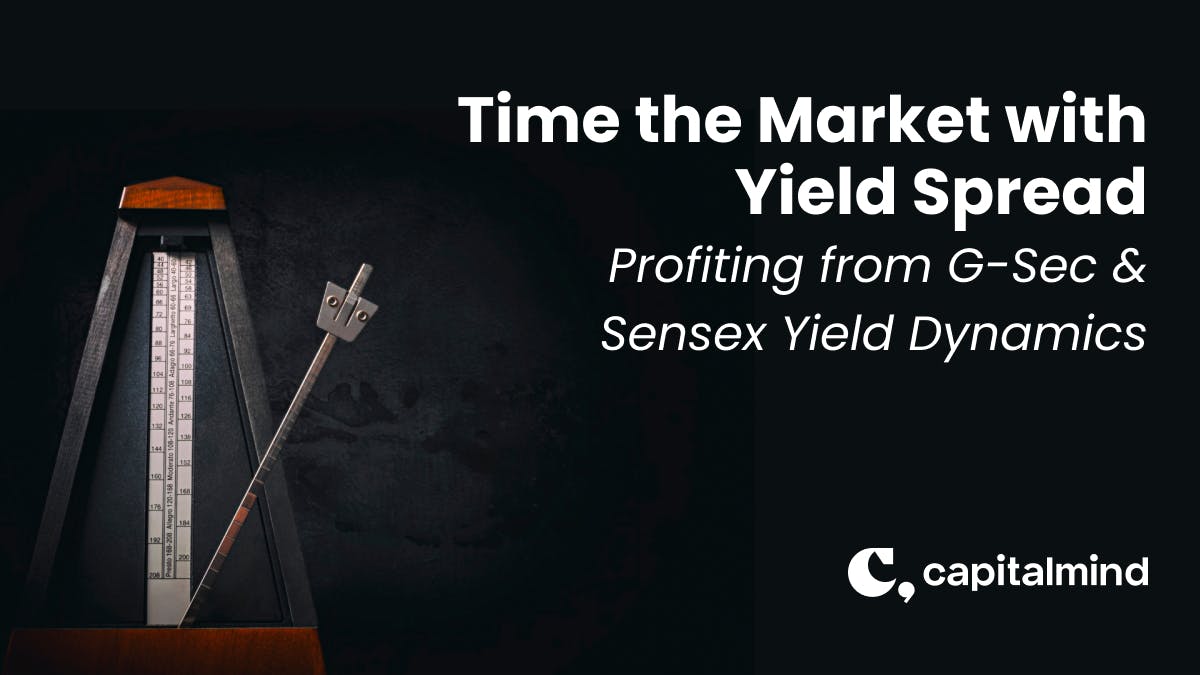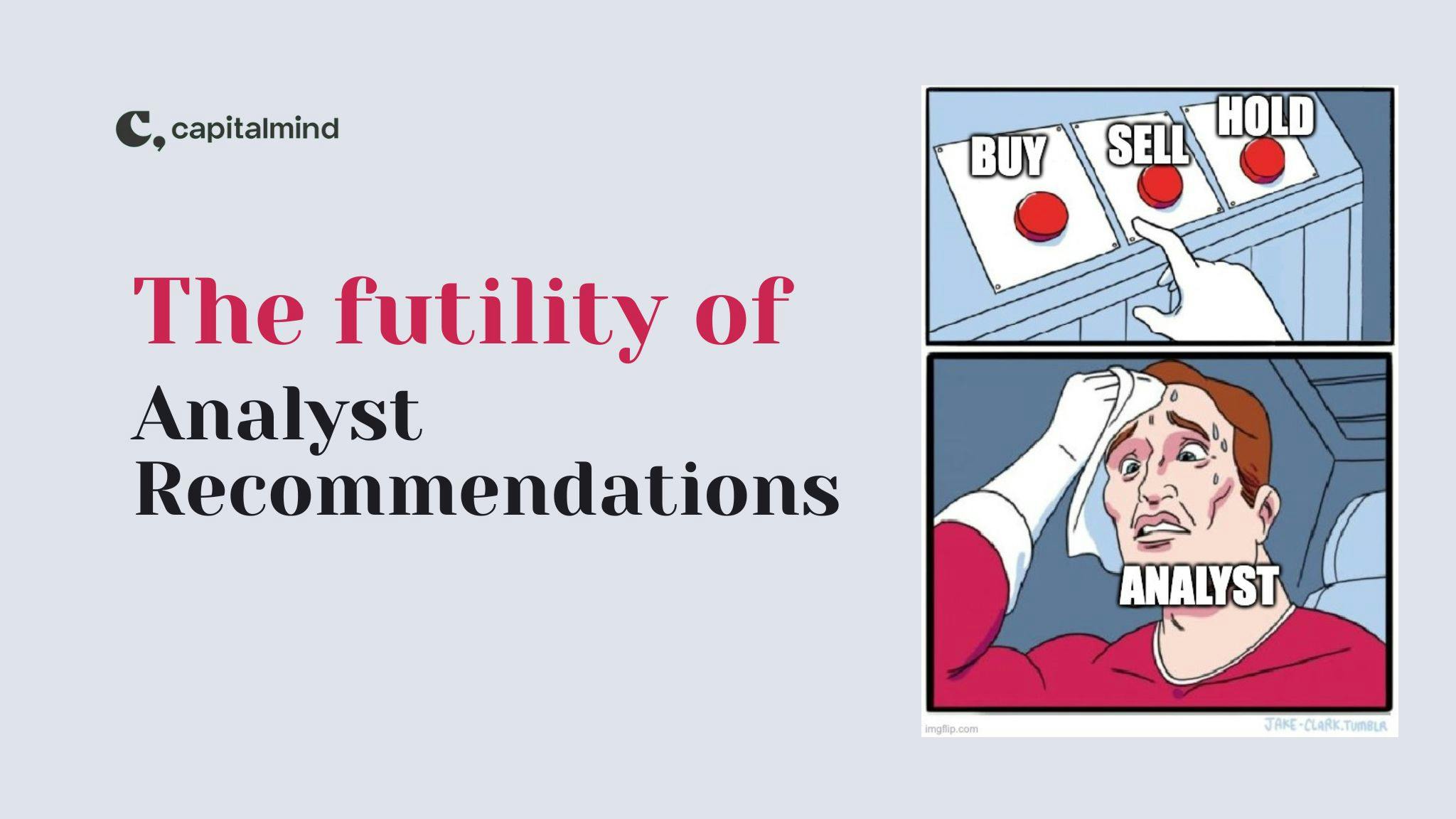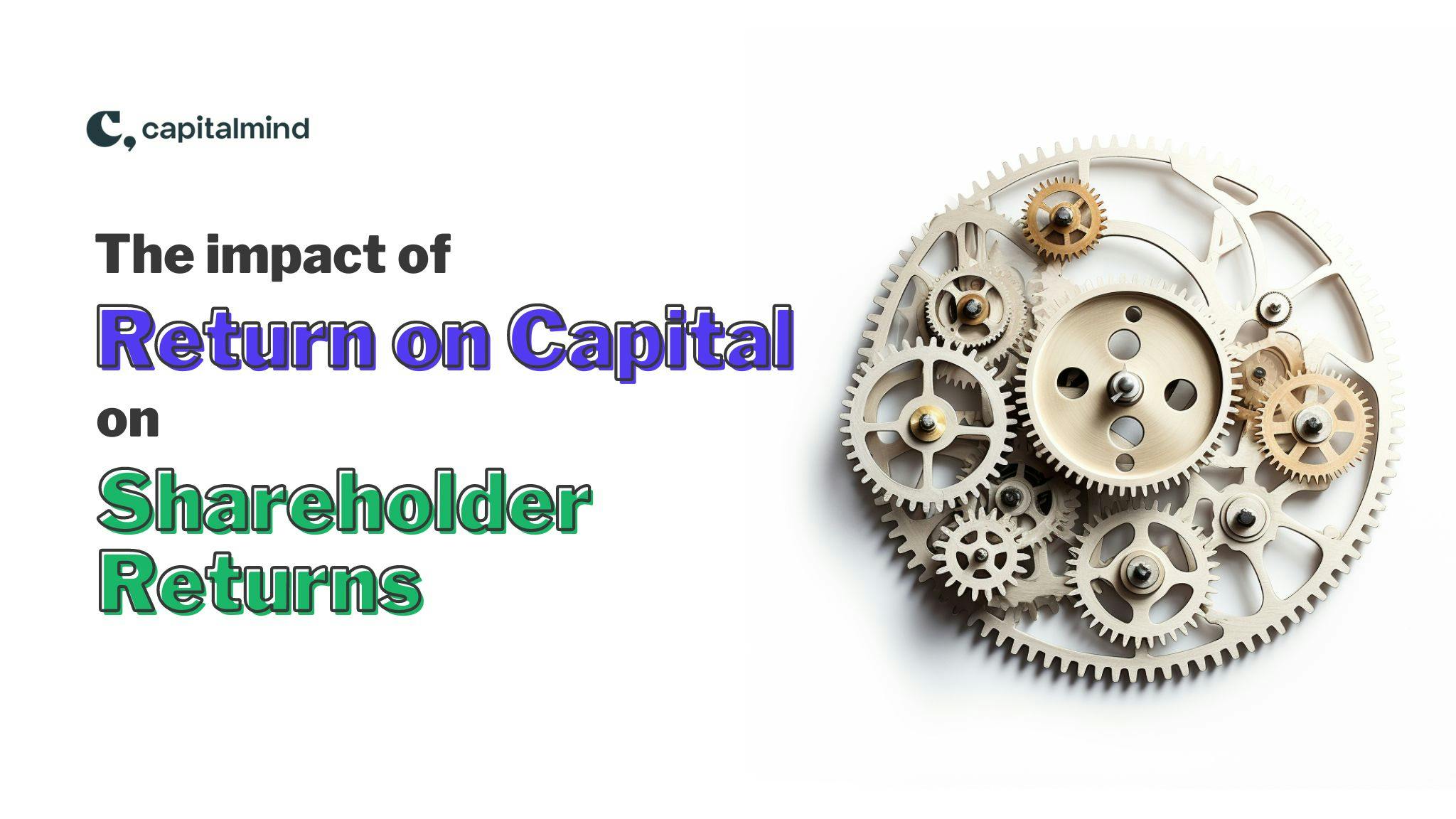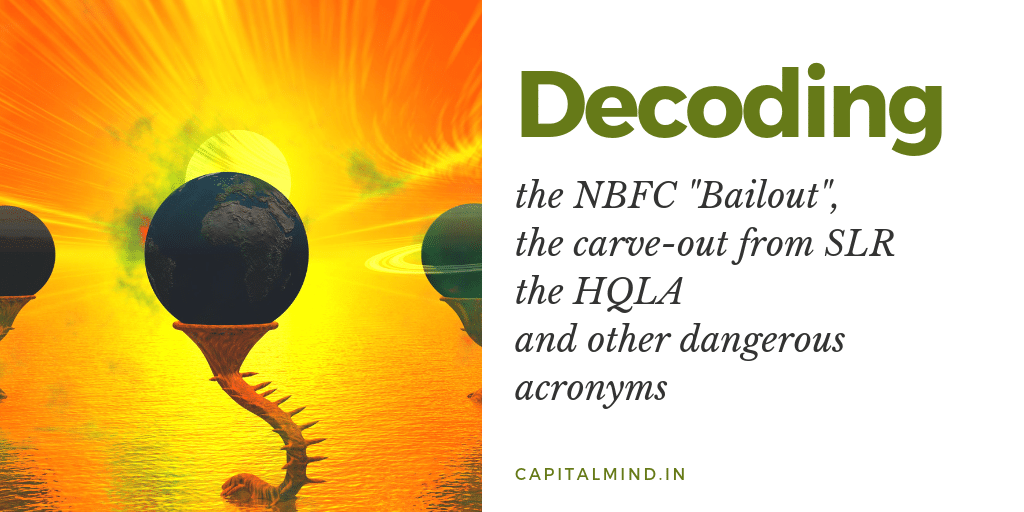(category)CM Strategy
The Yield Frontier: Profiting from G-Sec & Sensex Yield DynamicsThe Yield Frontier: Profiting from G-Sec & Sensex Yield Dynamics
Who doesn't want to time the market? Everyone looks out for the perfect time to shift from debt to equities and vice versa. In this post, we delve into the tactical allocation between equities and debt, as well as the role of interest rate cycles. Do we see a pattern here? Let's find out
Krishna Appala•

"At all times, in all markets, in all parts of the world, the tiniest change in interest rates changes the value of every financial asset." - Warren Buffett
A multitude of investors have read this quote, but only a small percentage of them might have truly understood its meaning. For those investing in equities long-term, it's as important to grasp the ups and downs of interest rate cycles as it is to understand the intricacies of financial statements.
Regardless of a company's outstanding growth prospects, the credibility of its promoters, strong financials, or the exceptional quality of its products, one crucial factor should guide your return expectations is the trajectory of interest rates.
The trend of interest rates will shed light on the direction of money flow, which in turn provides insights into:
- Whether money is becoming more expensive or cheap,
- If liquidity is entering or exiting the market,
- Is the cost of capital increasing or decreasing,
- The aggressiveness or caution of private companies regarding capital expenditures, and
- The potential re-rating or de-rating of a stock's PE
I think you got the gist. With this context in mind, let's delve into the correlation between interest rates and equities in the Indian market. By doing so, let's look at an approach to generate alpha by tactically transitioning between these two asset classes.
Problem Statement
- What is the correlation between long-term interest rates and equity returns in the Indian financial market?
- How can investors leverage this correlation to generate alpha and enhance their portfolio performance?
Hypothesis
- TIRS (Timing Interest Rate Spread), as we call it, is a strategy that involves two asset classes: Equity (represented by NiftyBees) and Debt (represented by Gilt Mutual Funds). At any given time, the entire investment is allocated to either Equity or Debt.
- We have to identify the optimal Entry & Exit criteria (yield spread) based on historical data.
- Once we derive the optimal spreads, test the strategy with different starting dates.
- Initially, for every trade, the portfolio is invested in Gilt Mutual Funds.
- If the entry criteria is met, the investment is shifted entirely to Equity by purchasing NiftyBees.
- If the exit criteria is met, the investment is moved out of Equity and reallocated entirely to Debt by purchasing SBI Magnum Gilt Fund.
- Rebalancing between NiftyBees and Gilts can occur whenever buy or sell signals are triggered. The strategy accounts for a T+2-day settlement period for both stock and bond transactions.
Here's a depiction of our approach. Using historical data, we establish the upper and lower boundaries of the Spread (Gsec - Sensex Earnings Yield). If the spread reaches the upper limit, we move to Debt; conversely, if the spread touches the lower limit, we shift to Nifty.
Assumptions
For this study, we have made these assumptions and taken into consideration the following instruments:
- 10-Year Gsec: This risk-free instrument tracks India's long-term interest rate cycle.
- SBI Magnum Gilt Fund: We have chosen SBI Magnum Gilt Fund (Growth), which invests in Gilt instruments and is one of the longest-running funds in this category as an investment vehicle for Debt.
- Earnings Yield: Earnings yield is the inverse of the PE ratio. In other words, the earnings yield helps investors understand how much they earned per share in percentage terms. For example, if a company has an earnings yield of 10%, it means that the investor has earned Rs. 10 for every Rs. 100 worth of shares owned. This provides an apple-to-apple comparison between Gilt Yields and Equity Yields. In our analysis, we used the Sensex Earnings Yield instead of the Nifty EY, as the Nifty started reporting consolidated EPS only in 2021, whereas the Sensex has been reporting consolidated EPS since 2004, making the Sensex PE (and its Sensex EY) more reliable for historical analysis in consolidated terms.
- NiftyBees: We considered NiftyBees, a widely traded instrument whose dividends are reinvested, as an investment vehicle for Equity.
- We took the last 15 years of data (since 2008) for backtesting purposes
- All the reported returns are on a pre-tax basis
Analyzing the Spread
To understand the relationship between G-Sec and Nifty 50 Earnings Yield, we calculated the spread between G-Sec and Sensex Earnings Yield (G-Sec minus Sensex Earnings Yield). The resulting spread shows the relative attractiveness of G-Secs and equities at any given point in time.
To further analyze this spread, we did a backtest using various trade scenarios, incorporating Entry (buying Equity) and Exit (selling Equity & buying Debt) for different spreads at intervals of 0.1%.
For instance, the maximum spread observed in the past 15 years was 4%, while the minimum was -3.7%. Consequently, we tested multiple combinations, such as entering into equities at -3.7% and exiting at -3.6%, entering at -3.7% and exiting at -3.5%, entry at 1% and exiting at 4%, and entry at 2% and exiting at 3.5%, etc. There were over 2700 such combinations since 2008.
Let's plot each of these trades and see if have a trend here.
*Click on the image to enlarge
How to interpret this chart?
- This scatter plot illustrates various trade combinations of Entry and Exit, with a spread difference of 0.1% for each combination
- X-axis: Entry spread
- Y-axis: Exit spread
- The distribution of CAGR is divided into 10 deciles, with light green representing the lowest decile and blue signifying the highest decile. Red indicates the spread combinations that underperformed Nifty.
Similarly, let's have a look at all the 90th percentile trades since 2008 and analyze their Entry & Exit spreads.
As you can observe, the historical data indicates that the highest CAGR (within the top 90th percentile) was attained with an entry spread of 1.6% and an exit spread of 3%.
Another way to check this data is to hold either the entry or exit variable constant and see if the CAGR is at its best. This is what it looks like:
If we keep the entry constant at 1.6% (which is the media), we can notice that the best CAGR returns for different starting points are roughly around 3%.
On the flip side, if we hold the exit constant at 3%, it turns out that the best CAGR returns happen when the entry is around 1.6%.
By examining the one-year forward returns of Nifty for these ranges, we can further validate the optimal spread, as shown in the chart below. The below chart indicates that the most favorable returns are now concentrated within the 1.5% to 2% range, once outliers are disregarded. It is important to note that as the spread widens, the one-year forward returns diminish and may even turn negative.
*Click on the image to enlarge
Now that we've identified & verified the ideal entry and exit spreads, let's put them to the test, beginning in 2008.
You might be wondering, why revisit these spreads when they already represent the median of our best-performing trades? Well, it's not just about evaluating the CAGR, but examining the entire process. We know the final outcome is promising, but let's also explore the journey to see how smooth it has been.
The strategy generated a higher CAGR with lower drawdown & volatility with respect to Nifty.
One key metric to assess the robustness of any strategy is by considering rolling returns. On a 1-year basis, the strategy outperformed Nifty about 73% of the time. This outperformance further increased to nearly 91% when viewed on a 3-year rolling return basis.
It gets better.
The drawdowns are not only lower at the overall trade level, but they also show the same trend on a year-wise basis.
Examining the calendar year-wise data of this strategy reveals periods of significant outperformance (36%, 32%, 35%) occurring occasionally, which have contributed to pushing the alpha in our favor. In other years, the strategy has largely followed the benchmark Nifty.
*Click on the image to enlarge
Do start dates matter? - No
Now: what if you just got lucky and invested at the perfect starting date? To remove the starting point dependency, we executed the strategy with various starting dates ranging from 2008 to 2013, providing at least 10 years or more to observe the results.
*Click on the image to enlarge
Few observations from the chart:
- The strategy consistently outperformed NiftyBees. However, the outperformance varied depending on your starting point.
- By investing the same amount at the beginning of every month and holding the investments until now, the SIP investor managed to outpace NiftyBees, generating an alpha of 5-6%
- Thanks to its debt component, the strategy's volatility was lower than that of NiftyBees.
- The strategy also experienced a lower drawdown compared to NiftyBees.
Limitations of TIRS strategy
- This is a passive strategy, where each trade continued for around 1.5 to 2 years before the next entry/exit trigger.
- Sometimes, it takes years before the strategy shows any outperformance over the Nifty. For example, if we consider the start year as 2009 and 2012, it took around 3 years for the Strategy NAV to outperform Nifty NAV.
- The backtested results are from the interest rate regime (G-Secs) that ranged between as high as 9.4% and as low as 5.8%. If interest rates move beyond this range, then we will be in alien waters.
What’s the bottom line?
- A lower spread suggests that equities are cheap (high earnings yield implies low PE) or that debt yields have fallen, making them less attractive. In both cases, it makes sense to shift to equities.
- A higher spread suggests that debt yields are rising, making them more attractive, or that equities have become expensive (low earnings yield = high PE). Thus, it would be wise to move to debt.
- Historically, equities have become more attractive when the spread reaches around the level of 1.6% and become overvalued when it reaches approximately 3%
- Drawdowns cannot be completely avoided. The strategy's drawdowns are still high at -29%, -22%, etc. However, they are better compared to Nifty during the same time.
- Returns come in bulk. If we miss those years, the performance may be muted. For example, as shown in the table above, the bulk of the outperformance came in 3 of the last 15 years, generating more than 30% alpha each year.
Further Reading:
- Time the market. Sleep better.
- On Market timing: What if you were the luckiest investor in India?
- Where do Superhero stocks come from?
Credit where it's due:
I first encountered the central concept of the relationship between G-Sec and Earnings Yield spread through my friend and former colleague, Navid Virani. Navid, who manages Bastion Research, can be found on both Twitter and LinkedIn.
A Study by Md. Mahmudul Alam & Md. Gazi Salah Uddin in this paper Relationship between Interest Rate and Stock Price discussing stock price dependencies on Interest rates across developing counties.
A study by David Blitz talks about Expected Stock Returns When Interest Rates Are Low and equity risk premiums across countries.
Disclaimer: This post is for information only and should not be considered a recommendation to buy or sell stocks. The analysis is based on data from reliable sources, but do point out any discrepancies you find.
Related Posts
Make your money work as hard as you do.
Talk to a Capitalmind Client AdvisorInvesting is not one size fits all
Learn more about our distinct investment strategies and how they fit into your portfolio.
Learn more about our portfoliosUnlock your wealth potential
Start your journey today







